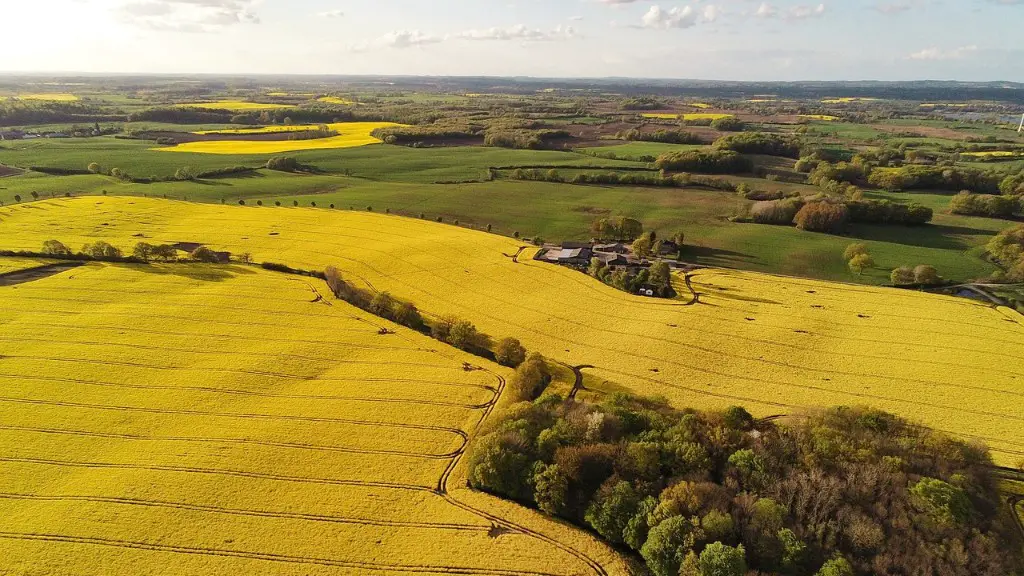California, the most populous of the US states and most productive agriculturally, uses a staggering 40 percent of its water for agricultural activities. This is far more than the entire national average of 35 percent and is the highest of any state in the US. California’s agricultural industry relies heavily on irrigation, or the application of water from sources like rivers, lakes, or groundwater, to sustain crop production. California supplied irrigation water to almost 5 million acres of land in 2017, but increased human activity and changing weather patterns have decreased the amount of available water for agricultural and other uses. This puts a huge strain on the resources available and poses a fundamental challenge to California’s agriculture industry and economy.
What are the Water Sources in California?
California’s water sources are divided into various categories, including surface, groundwater, recycled and imported water. Surface water includes rivers, lakes, and streams and is collected in large reservoirs. In California, rivers like the Sacramento and San Joaquin rivers and lakes like Clear Lake and New Bullards Bar Reservoir are crucial water sources for agriculture. Groundwater is water that is stored in underground aquifers and is also extremely important for California agriculture. Recycled water is any treated wastewater that is reused for irrigation and other agriculture applications. Finally, imported water is water from outside sources like the Colorado River and other states and is often used to supplement water from within the state.
How Much of the Water is Used by Agriculture?
Almost 40 percent of California’s usable water was used for agricultural purposes in 2017, amounting to about 11 million acre-feet of water for agricultural activities. The agricultural industry is the biggest user of water in the state and accounts for substantially more water usage than any other sector, including domestic and industrial. In dry years, agricultural water use is even more significant, accounting for more than half of all water used in the state. California’s Central Valley relies largely on surface water, while coastal and southern areas depend more heavily on groundwater supplies. While the majority of agricultural water comes from surface water sources, there is a growing trend of irrigators transitioning away from surface water sources to groundwater.
What are the Challenges Faced by Agriculture?
California’s agricultural sector is facing a number of different challenges related to water availability and sustainability. The state is facing increasingly longer and more severe droughts, a growing population and increased demand for water, and a diminishing water supply from surface water sources like rivers and reservoirs. Additionally, groundwater is becoming increasingly depleted, leading to declining water levels and well failure. The price of water is also on the rise, making it increasingly difficult for small farmers and producers to afford. These challenges are leading to an increase in crop failure, reduced yields, and other negative impacts to California’s agriculture industry.
What are the Implications of Reduced Water Supply?
The implications of a reduced water supply on the agriculture industry in California are pronounced and far-reaching. Reduced water availability leads to crop failure, lower yields, and decreased profits. In addition, farmers may be forced to over-irrigate to compensate for a lack of water, leading to increased water contamination and salinization of soil. Water scarcity also means that farmers have to compete for the limited resources available, leading to an increase in water prices and a decrease in irrigation efficiency. In short, the decreased availability of water has the potential to adversely affect the entire agricultural industry in California if solutions are not implemented.
What are the Solutions to Increase Water Supply?
In order to address the water scarcity facing California’s agriculture industry, a number of solutions have been proposed. The most common solutions involve more efficient water usage practices, like drip irrigation and other water-saving methods. Additionally, agricultural producers can use alternative water sources, like recycled water and storm runoff, to supplement water supplies. Additionally, the use of more water-efficient crops and improved field practices can help conserve water and reduce water needs. Finally, there has been an effort to increase water storage capacity with larger and more efficient reservoirs.
What is the Impact of Water Conservation?
Conserving water is becoming increasingly important for California’s agriculture industry as the state’s water supply continues to decline and droughts become more severe and frequent. Conservation efforts have a number of benefits, including fewer restrictions on water availability, lower water bills, improved water quality, and increased profits and yields. Additionally, conserving water helps to protect the environment and to maintain the diversity of California’s landscapes. Thus, the impacts of water conservation on California’s agriculture have far-reaching implications and should not be underestimated.
What Other Strategies Are Being Put In Place?
In addition to increased conservation, there are a number of other strategies being implemented to address the water issues facing California’s agriculture. These strategies include the use of greywater, water conservation incentives, and the implementation of regional water management solutions. Greywater is wastewater from domestic activities like washing dishes or clothes and can be reused to supplement irrigation needs. Additionally, there are water conservation incentives that reward farmers and ranchers for implementing more efficient water practices. Finally, regional water management solutions are being developed to manage water usage throughout the state in a more equitable and sustainable manner.
What Role Does Technology Play?
Technology is also playing an important role in improving water management and conservation in California. New technologies, like remote sensing and automation technologies, are being used to monitor and manage water resources in real-time. These technologies can be used to track weather patterns, soil moisture levels, and water flow, allowing for more accurate and efficient water management decisions. Additionally, online dashboards and mobile apps can be used to monitor water use and help farmers control water usage from anywhere.
How Can We Improve Water Management?
In order to improve water management in California, there are a number of strategies that can be implemented. These include increasing public education and awareness about the importance of water conservation, incentivizing more efficient water management practices, and investing in infrastructure that can help to conserve and manage water resources more effectively. Additionally, utilizing new technologies, like those mentioned above, can help to better monitor and manage water use and can help to improve water sustainability in the long-term.


